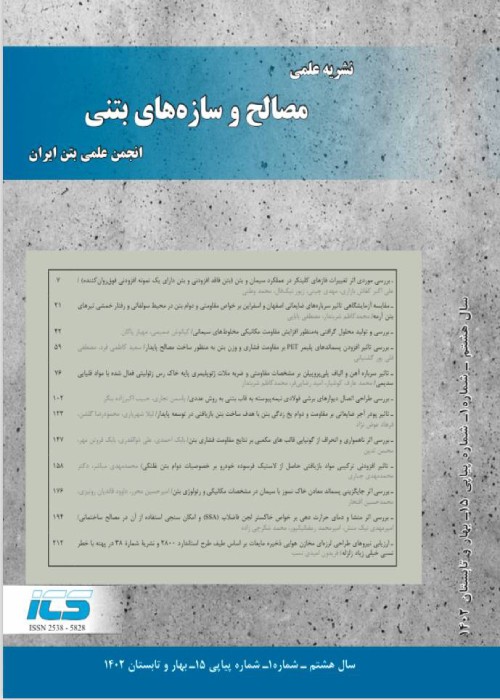Evaluation of Seismic Design Forces of Elevated Water Tanks in Different Editions of Standard 2800 in Different Zones of Relative Hazard of Earthquake and Soil Types
Author(s):
Article Type:
Research/Original Article (دارای رتبه معتبر)
Abstract:
Liquid storage tanks are one of the main components of vital arteries that should be able to continue their service during and even after the earthquake and maintain their uninterrupted usability. For this reason, seismic safety of liquid storage tanks is of considerable importance to ensure the water supply of earthquake-affected areas and fire extinguishing. Tanks of industrial liquids may also contain valuable liquids or employment that should not lose their contents during an earthquake. Elevated tanks are often used for water storage purposes and can be placed on prestressed concrete shafts, prestressed metal or concrete frames or stage of masonry. Most design standards use this conclusion and have higher seismic design performance for reservoirs compared to other buildings. In this study, the first to fourth editions of standard 2800 for elevated water tanks in four types of relative earthquake risk and four types of soil defined in the standard have been investigated and compared with the most ductile building in the relevant standard. In standard 2800 for aerial water tanks in the first to third editions, only one coefficient of behavior is presented, but in the fourth edition, two coefficients of behavior are considered. By examining the tanks and ductile buildings, their seismic design force was compared and while comparing these results, the differences between different edits of standard 2800 were investigated. The results showed that in standard 2800, in the first to third editions of standard 2800, for different soils and regions with relative earthquake risk, the seismic design force of elevated tanks is about 3 to 7 times more than the ductile buildings of the relevant edition. If in the fourth edition, this range has increased so that the seismic design force of elevated tanks is about 2.14 to 9.33 times more than the ductile buildings. Also, in the fourth edition of standard 2800, for reservoirs with behavior coefficients of 2 and 3, in soil type IV, for regions with different relative risks, there is no high bound (in long periods) and for tanks with behavior coefficient 2 and in soil type II, at low and moderate risk level of earthquake, there is no low bound (in long periods).
Keywords:
Language:
Persian
Published:
Journal of Concrete Structure and Materials, Volume:7 Issue: 1, 2023
Pages:
163 to 180
magiran.com/p2564297
دانلود و مطالعه متن این مقاله با یکی از روشهای زیر امکان پذیر است:
اشتراک شخصی
با عضویت و پرداخت آنلاین حق اشتراک یکساله به مبلغ 1,390,000ريال میتوانید 70 عنوان مطلب دانلود کنید!
اشتراک سازمانی
به کتابخانه دانشگاه یا محل کار خود پیشنهاد کنید تا اشتراک سازمانی این پایگاه را برای دسترسی نامحدود همه کاربران به متن مطالب تهیه نمایند!
توجه!
- حق عضویت دریافتی صرف حمایت از نشریات عضو و نگهداری، تکمیل و توسعه مگیران میشود.
- پرداخت حق اشتراک و دانلود مقالات اجازه بازنشر آن در سایر رسانههای چاپی و دیجیتال را به کاربر نمیدهد.
In order to view content subscription is required
Personal subscription
Subscribe magiran.com for 70 € euros via PayPal and download 70 articles during a year.
Organization subscription
Please contact us to subscribe your university or library for unlimited access!


